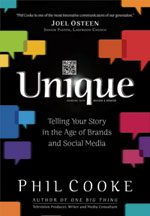
By Brandon Cox
Everywhere we communicate, we convey emotion and send a message about our identity.
 A brand is not a logo, and a logo is not a brand. Phil Cooke, in his great book Branding Faith says, “A brand is the story people tell about a person, product, or organization.” Logos and other forms of visual imagery simply help us to create an emotional trigger that prompts people to associate our story with our name. Or as I like to put it, visual branding helps us to frame our story well.
A brand is not a logo, and a logo is not a brand. Phil Cooke, in his great book Branding Faith says, “A brand is the story people tell about a person, product, or organization.” Logos and other forms of visual imagery simply help us to create an emotional trigger that prompts people to associate our story with our name. Or as I like to put it, visual branding helps us to frame our story well.
One of the most common mistakes church leaders make is to jump into the visual design process in search of the nicest looking persona without considering whether the final look really represents our organizational culture or not.
Everywhere we communicate, online or in print, we convey emotion and send a message about our identity.
Warm colors and soft textures convey one feeling, while earth tones communicate a different feeling. Cool, clean imagery communicates order, while grungy, dirty textures give a sense of chaos. One style isn’t necessarily better or worse than another, but our approach to aesthetics needs to reflect who we are.
Intentional  design
design
When we designed the logo for Grace Hills Church, we were rather intentional, even though the logo is simple. We used a diamond shape, subtly connecting us with our roots as a purpose driven church (a movement in which a baseball diamond is often used to illustrate progressive maturity).
And we use bright greens to connect us with the idea of freshness and growth. Our hope is that when people see our logo, their minds recall a story about a place where people can really discover a new, fresh start in life.
Before you hit the drawing board or hire your next graphic designer, do some organizational soul searching and answer some important questions about your identity, such as:
- What are three phrases with which we would like people to describe our church?
- What single iconic image comes to mind as our primary leader describes us? And remember, it doesn’t have to be a dove, a cross or a globe.
- What kind of emotion do we believe people need to feel as they encounter us for the first time, and what kind of color palette conveys that emotion?
- What imagery do we need to eliminate from our current branding to avoid distracting people from our core identity?
- How can we present a unique picture of ourselves that differentiates us from other churches in our vicinity?
Once you’ve gone through a thorough review process, dreaming together and articulating your organizational story, it’s time to design. Whether you handle this process in-house or with help from a firm or freelancer, you must keep your story as the priority over aesthetics consistently. The designer’s responsibility is not to write the story, but to tell it accurately and passionately.
Being consistent
It’s intriguing how many organizations present one style in print and another on the web, while presenting a third version of their story with the decor of their building. Consider the brands you know well.
The imagery of McDonald’s is consistent from their signage to their drink cups to their straw wrappers – golden arches. Target’s coupon mailers have the same clean feel and the same red dot and the same spotted dog as the front of their building and their website.
You can’t always control the story that is told about you. Public relations professionals know this all too well. But you can be intentional about framing the story well by keeping your branding strong, consistent and true to your real organizational identity.
Brandon Cox is lead pastor at Grace Hills Church in northwest Arkansas and also serves as editor and community facilitator for Pastors.com and Rick Warren’s Pastor’s Toolbox newsletter. He is writing his first book, Rewired, to help churches communicate the Gospel in a rapidly changing age.


